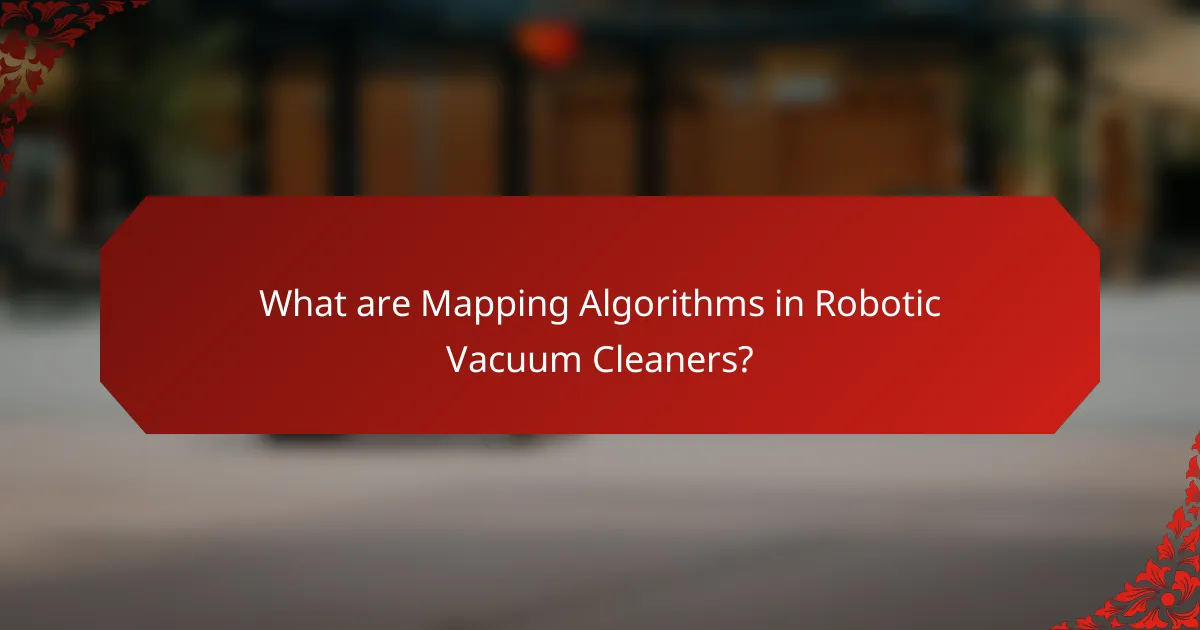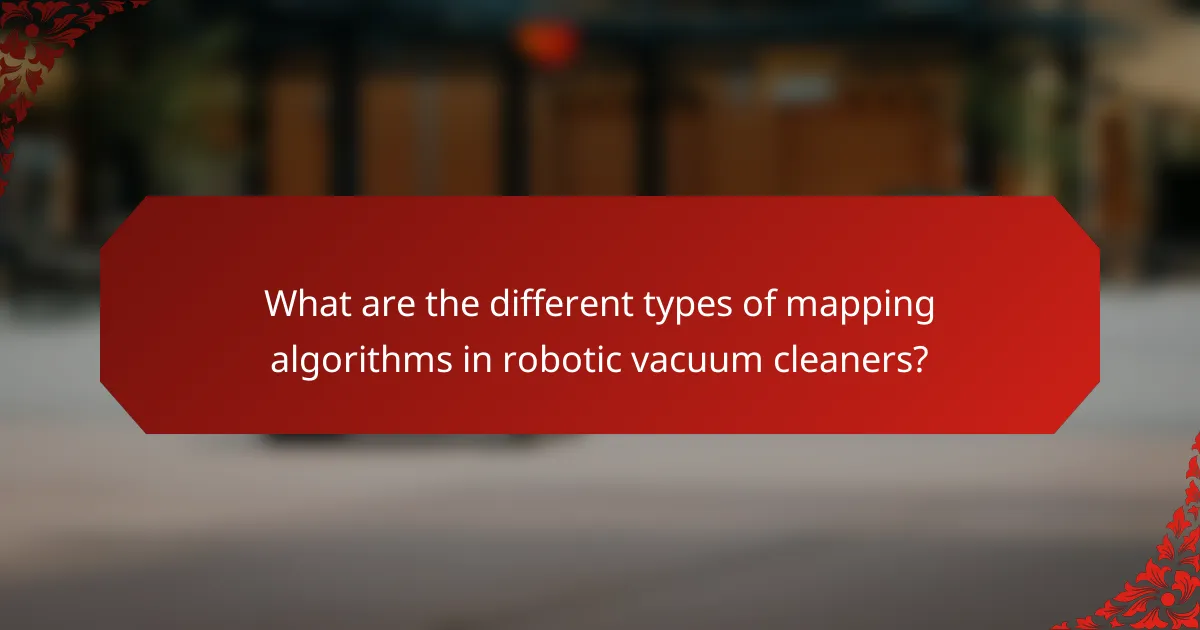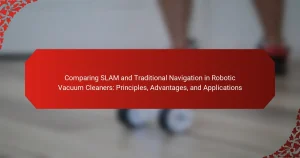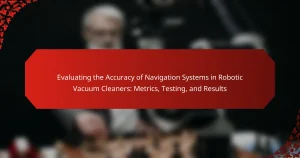Mapping algorithms are essential methods used in robotic vacuum cleaners to create efficient cleaning paths and navigate environments. These algorithms, including reactive mapping, systematic mapping, and simultaneous localization and mapping (SLAM), leverage technologies such as sensors and cameras to gather data and build virtual layouts of spaces. By adapting to changes in the environment, these algorithms enhance cleaning performance, ensuring thorough coverage and obstacle avoidance. The article explores the functions of different mapping algorithms and their impact on user experience, highlighting how advanced mapping capabilities contribute to increased user satisfaction and improved cleaning efficiency.

What are Mapping Algorithms in Robotic Vacuum Cleaners?
Mapping algorithms in robotic vacuum cleaners are methods used to create a map of the cleaning area. These algorithms help the vacuum navigate efficiently and avoid obstacles. They utilize various technologies, such as sensors and cameras, to gather data about the environment. This data is processed to generate a virtual layout of the space. The algorithms can adapt to changes in the environment over time. They ensure thorough cleaning by optimizing the path taken by the vacuum. Many modern robotic vacuums use advanced mapping algorithms like simultaneous localization and mapping (SLAM). SLAM allows the vacuum to build and update its map in real-time as it cleans.
How do mapping algorithms function in robotic vacuum cleaners?
Mapping algorithms in robotic vacuum cleaners create a digital layout of the cleaning area. These algorithms utilize sensors to detect obstacles and measure distances. They generate maps by analyzing data from laser sensors or cameras. The vacuum cleaner then uses this map for efficient navigation.
For example, SLAM (Simultaneous Localization and Mapping) is a common algorithm employed. It allows the robot to build a map while tracking its location within that map. This process helps in optimizing cleaning paths and avoiding repeated coverage of areas.
Research indicates that effective mapping enhances cleaning efficiency by up to 30%. This efficiency is crucial for user satisfaction and overall performance of robotic vacuum cleaners.
What types of sensors are used in mapping algorithms?
Robotic vacuum cleaners utilize various types of sensors in mapping algorithms. Common sensors include LIDAR sensors, which measure distances using laser beams. They provide precise spatial data for creating detailed maps. Ultrasonic sensors are also used; they emit sound waves to detect obstacles and measure distances. Infrared sensors help identify nearby objects and boundaries. Additionally, cameras can capture visual data for navigation and mapping. Each sensor type contributes uniquely to the overall mapping process, enhancing the robot’s efficiency. The integration of these sensors allows for improved path planning and obstacle avoidance in robotic vacuum cleaners.
How do different mapping techniques influence cleaning efficiency?
Different mapping techniques significantly influence cleaning efficiency in robotic vacuum cleaners. Techniques such as visual mapping and LIDAR create detailed floor plans. These detailed maps allow for optimized cleaning paths. Efficient paths reduce the time spent cleaning. Additionally, real-time mapping adjusts to obstacles dynamically. This adaptability prevents missed spots and enhances coverage. Studies show that LIDAR-equipped vacuums clean up to 30% faster than those using basic sensors. Overall, advanced mapping techniques lead to more thorough and efficient cleaning outcomes.
Why are mapping algorithms important for robotic vacuum cleaners?
Mapping algorithms are important for robotic vacuum cleaners because they enable efficient navigation and cleaning. These algorithms allow the vacuum to create a detailed map of the environment. The map helps the vacuum identify obstacles and plan optimal cleaning routes. Efficient navigation reduces cleaning time and ensures thorough coverage of the area. According to a study by the International Journal of Advanced Robotic Systems, robotic vacuums equipped with mapping algorithms can clean up to 30% more area than those without. This efficiency enhances user satisfaction and reduces the need for manual intervention.
What advantages do mapping algorithms provide over traditional cleaning methods?
Mapping algorithms enhance cleaning efficiency compared to traditional methods. They create detailed maps of the cleaning area. This allows for systematic cleaning patterns rather than random paths. As a result, coverage is more thorough and consistent. Mapping algorithms can also adapt to obstacles in real-time. This reduces the likelihood of missed spots or collisions. Furthermore, they enable targeted cleaning in specific areas. Users can select rooms or zones for focused cleaning. Research shows that robotic vacuums using mapping algorithms clean up to 30% more area than traditional models.
How do mapping algorithms enhance user control and convenience?
Mapping algorithms enhance user control and convenience by providing precise navigation and customizable cleaning routes. These algorithms allow robotic vacuum cleaners to create detailed maps of the environment. Users can set specific cleaning areas or avoid certain zones. This level of control increases efficiency and reduces cleaning time. Additionally, algorithms adapt to changes in the environment, ensuring optimal performance. Research shows that precise mapping can improve cleaning coverage by up to 30%. Overall, mapping algorithms significantly improve user experience by offering tailored cleaning solutions.

What are the different types of mapping algorithms in robotic vacuum cleaners?
The different types of mapping algorithms in robotic vacuum cleaners include reactive mapping, systematic mapping, and simultaneous localization and mapping (SLAM). Reactive mapping uses sensors to detect obstacles and navigate in real-time. Systematic mapping follows a predetermined path to cover the entire area efficiently. SLAM combines mapping and localization, allowing the vacuum to create a map while determining its position within that map. Each algorithm has distinct advantages, such as efficiency and adaptability to various environments. These algorithms enhance the cleaning performance and user experience by ensuring thorough coverage and obstacle avoidance.
What are the primary types of mapping algorithms used?
The primary types of mapping algorithms used in robotic vacuum cleaners include SLAM, grid mapping, and landmark-based mapping. SLAM stands for Simultaneous Localization and Mapping. This algorithm allows the robot to create a map of an unknown environment while tracking its location within that environment. Grid mapping divides the area into a grid and updates the status of each cell based on sensor data. Landmark-based mapping uses identifiable features in the environment to aid navigation and mapping. Each type of algorithm has its advantages. SLAM is effective in dynamic environments, while grid mapping is useful for systematic coverage. Landmark-based mapping enhances accuracy in familiar spaces. These algorithms are crucial for optimizing the cleaning efficiency of robotic vacuum cleaners.
How does simultaneous localization and mapping (SLAM) work?
Simultaneous localization and mapping (SLAM) enables a robot to create a map of an unknown environment while simultaneously tracking its location within that environment. SLAM uses sensors such as cameras and LIDAR to gather data about surroundings. The algorithm processes this data to identify features and landmarks. It employs mathematical models to estimate the robot’s position relative to these features. As the robot moves, it continuously updates the map and its location. This iterative process enhances accuracy over time. SLAM is essential for robotic vacuum cleaners, allowing them to navigate efficiently without pre-existing maps. Studies show that effective SLAM algorithms significantly improve navigation and cleaning coverage in robotic systems.
What is the role of visual mapping in robotic vacuum cleaners?
Visual mapping in robotic vacuum cleaners enables precise navigation and efficient cleaning. It allows the device to create a detailed map of the environment. This mapping helps the vacuum identify obstacles and plan optimal cleaning paths. Visual mapping enhances the robot’s ability to avoid collisions and navigate complex spaces. It improves the overall cleaning coverage by ensuring that no areas are missed. Many robotic vacuum cleaners use cameras and sensors for this visual mapping process. Studies have shown that vacuums with visual mapping can clean up to 30% more efficiently than those without. This technology ultimately leads to a better user experience and satisfaction.
How do various mapping algorithms impact cleaning performance?
Various mapping algorithms significantly influence cleaning performance in robotic vacuum cleaners. These algorithms determine how effectively the robot navigates and covers the cleaning area. For example, simultaneous localization and mapping (SLAM) algorithms enhance spatial awareness, allowing the robot to avoid obstacles and clean efficiently. In contrast, basic reactive algorithms may lead to random cleaning paths, resulting in missed spots. Studies show that robots using advanced mapping algorithms can clean up to 30% more area compared to those with simpler methods. Additionally, the accuracy of the map affects the robot’s ability to return to charging stations and complete cleaning cycles. Overall, the choice of mapping algorithm directly correlates with the effectiveness and thoroughness of the cleaning process.
What are the differences in cleaning coverage among mapping algorithms?
Cleaning coverage varies among mapping algorithms based on their efficiency and precision. Different algorithms utilize distinct methods for room mapping and obstacle detection. For instance, some algorithms employ laser-based mapping, which offers high accuracy in detecting room layouts. Others may use visual mapping, which can be less precise but faster in familiar environments.
Moreover, grid-based algorithms provide systematic coverage by dividing spaces into smaller sections. In contrast, random navigation algorithms may lead to uneven coverage, resulting in missed spots. Studies show that laser mapping can cover up to 95% of the area in a single pass, while random algorithms may achieve only 70% coverage.
These differences impact overall cleaning performance and user satisfaction. Users often prefer algorithms that ensure thorough coverage and minimize missed areas.
How do mapping algorithms affect battery life and efficiency?
Mapping algorithms significantly impact battery life and efficiency in robotic vacuum cleaners. These algorithms determine the optimal cleaning path, which reduces unnecessary movement. Efficient path planning minimizes the distance traveled, conserving battery power. A well-designed mapping algorithm can also prioritize areas that require more cleaning, thus optimizing energy usage.
For instance, studies show that robotic vacuums using advanced mapping algorithms can complete cleaning tasks using up to 30% less battery compared to those using basic algorithms. This efficiency leads to longer operational times before recharging is needed. The effectiveness of these algorithms directly correlates with improved cleaning coverage and reduced energy consumption.

How do mapping algorithms influence user experience with robotic vacuum cleaners?
Mapping algorithms significantly enhance user experience with robotic vacuum cleaners. They enable efficient navigation and cleaning paths. This leads to reduced cleaning time and improved coverage of spaces. Users benefit from features like scheduled cleaning and remote control via apps. Advanced algorithms allow for real-time mapping and obstacle avoidance. This minimizes the chances of the vacuum getting stuck or missing spots. Studies show that models with superior mapping capabilities increase user satisfaction. For instance, a survey by Consumer Reports found that users rated mapping technology as a key factor in their overall satisfaction.
What features do mapping algorithms enable for users?
Mapping algorithms enable users to optimize cleaning efficiency in robotic vacuum cleaners. They help create detailed maps of the environment. This allows for systematic cleaning paths. Users benefit from features like area-specific cleaning. They can designate no-go zones for the device. Mapping algorithms also enable the ability to save multiple floor plans. This is useful for multi-level homes. Additionally, algorithms enhance the device’s navigation capabilities. They reduce the chances of getting stuck or lost. Overall, these features improve user control and satisfaction with robotic vacuum performance.
How do users interact with mapping data from their robotic vacuum cleaners?
Users interact with mapping data from their robotic vacuum cleaners primarily through mobile applications. These applications display real-time maps of the cleaned areas. Users can view the vacuum’s cleaning path and identify missed spots. They can also set virtual boundaries on these maps. This feature prevents the vacuum from entering certain areas. Users often customize cleaning schedules based on the mapping data. The data helps optimize cleaning efficiency by allowing targeted cleaning sessions. Many robotic vacuums provide updates on cleaning performance via these applications. This interaction enhances user control and satisfaction with the device.
What customization options are available through mapping algorithms?
Mapping algorithms in robotic vacuum cleaners offer several customization options. Users can set specific cleaning schedules. They can create no-go zones to prevent the vacuum from entering certain areas. Users can also define cleaning modes, such as spot cleaning or edge cleaning. Additionally, some algorithms allow for room-specific cleaning preferences. These features enhance user control and improve cleaning efficiency. Customization options vary by model and brand, providing tailored experiences.
What common challenges do users face with mapping algorithms?
Users face several common challenges with mapping algorithms in robotic vacuum cleaners. One challenge is inaccurate mapping, where the vacuum fails to create a precise layout of the environment. This can lead to missed areas or repeated cleaning of the same spots. Another issue is the inability to recognize obstacles effectively. This can result in the vacuum getting stuck or damaging furniture.
Users also report difficulties with real-time updates of the map. Changes in the environment, such as moved furniture, may not be reflected immediately. Additionally, some users experience limitations in the algorithm’s ability to adapt to complex room layouts. This can hinder efficient cleaning paths.
Battery life can also be a challenge. If the vacuum runs out of power before completing the mapped area, it may not return to where it left off. Finally, integration with smart home systems can be problematic. Some users find that mapping algorithms do not sync well with other devices, limiting overall functionality.
How can users troubleshoot mapping inaccuracies in their devices?
Users can troubleshoot mapping inaccuracies in their devices by recalibrating the mapping system. First, they should ensure the device is fully charged and powered on. Next, users should clear any obstacles in the cleaning area to allow for accurate mapping. It is also crucial to reset the device to factory settings if inaccuracies persist. Users can then initiate a new mapping run for the device to create an updated map. Checking for software updates is essential, as manufacturers often release patches to improve mapping algorithms. Finally, consulting the user manual can provide device-specific troubleshooting steps. These methods are supported by user feedback and manufacturer guidelines, which emphasize the importance of maintaining a clear environment for optimal mapping performance.
What are the best practices for optimizing mapping performance?
Use efficient algorithms to enhance mapping performance. Algorithms like A* or Dijkstra’s can minimize pathfinding time. Optimize sensor data processing to reduce latency. This ensures timely updates to the map. Implement incremental mapping to allow real-time adjustments. It helps maintain accuracy as the robot navigates. Utilize a robust localization method to improve positioning. Accurate localization directly impacts mapping precision. Regularly update the mapping software to incorporate improvements. Software updates can enhance performance and fix bugs. These practices collectively improve the efficiency and accuracy of robotic vacuum mapping.
What tips can enhance user experience with robotic vacuum cleaners and mapping algorithms?
To enhance user experience with robotic vacuum cleaners and mapping algorithms, users should regularly update the device’s software. This ensures access to the latest features and improvements. Users should also optimize room layouts by removing obstacles before cleaning. A clear space allows for more efficient mapping and cleaning. Scheduling cleaning times during low-traffic periods can improve effectiveness. This minimizes interruptions and enhances performance. Users can also take advantage of virtual barriers to protect sensitive areas. This feature helps maintain a cleaner environment. Finally, users should familiarize themselves with the app interface for better control. Understanding the app can lead to more effective use of mapping features and settings.
The main entity of the article is mapping algorithms in robotic vacuum cleaners, which are essential for creating efficient navigation and cleaning paths. The article explores various types of mapping algorithms, including simultaneous localization and mapping (SLAM), and examines their functions, such as obstacle detection and real-time updates. It highlights the impact of these algorithms on cleaning efficiency, user control, and overall user experience, emphasizing how advanced mapping techniques can enhance performance and satisfaction. Additionally, the article addresses common challenges users may face with mapping inaccuracies and offers best practices for optimizing mapping performance.


